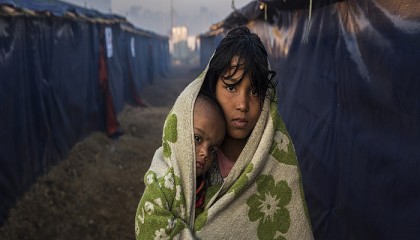Diplomatic correspondent
Published:2020-12-02 01:19:58 BdST
UN appeals for $35 billion to help world’s ‘most vulnerable and fragile’ in 2021
*235 million people worldwide will need humanitarian assistance and protection in 2021
*UN plans to reach 160 million most vulnerable people at a cost of $35 billion
*56 countries affected by humanitarian crises
*UN chief calls on the world to stand with people in their darkest hour of need
A record 235 million people will need humanitarian assistance and protection next year, a near- 40 per cent increase on 2020 which is “almost entirely from COVID-19”, the UN’s emergency relief chief said on Tuesday .
In an appeal for $35 billion to meet humanitarian needs next year, Mark Lowcock said global health crisis had impacted dramatically people already reeling from conflict, record levels of displacement, climate change shocks. He said that “multiple” famines are looming.
The situation is “desperate” for millions and has left the UN and partners “overwhelmed”, he added.
“The picture we are presenting is the bleakest and darkest perspective on humanitarian needs in the period ahead that we have ever set out. That is a reflection of the fact that the COVID pandemic has wreaked carnage across the whole of the most fragile and vulnerable countries on the planet.”
Echoing Lowcock’s call for global solidarity, UN Secretary-General António Guterres urged the world to “stand with people in their darkest hour of need”, as the global pandemic continues to worsen.
Although the humanitarian system had delivered “food, medicines, shelter, education and other essentials to tens of millions of people “the crisis is far from over”, the UN chief insisted in a statement.
"The humanitarian system again proved its worth in 2020, delivering food, medicines, shelter, education and other essentials to tens of millions of people," he said.
"But the crisis is far from over. Humanitarian aid budgets face dire shortfalls as the impact of the global pandemic continues to worsen. Together, we must mobilize resources and stand in solidarity with people in their darkest hour of need," Guterres added.
This year’s Global Humanitarian Overview (GHO) sets out plans “to reach 160 million of the most vulnerable people in 56 countries and most plans, if they are fully financed, will cost $35 billion”, Lowcock said.
He noted that while richer countries had invested some $10 trillion in staving off economic disaster from the COVID-induced slump and could now see “light at the end of the tunnel…the same is not true in the poorest countries”.
The COVID-19 crisis had lunged millions into poverty “and sent humanitarian needs skyrocketing,” Lowcock explained, adding that aid funding was needed to “stave off famine, fight poverty, and keep children vaccinated and in school”.
Cash will also be used from the UN’s Central Emergency Relief Fund (CERF) to tackle rising violence against women and girls linked to the pandemic, Lowcock said.
The GHO 2021 sets out 34 response plans covering 56 vulnerable countries. GHO 2021 is the world’s most comprehensive, authoritative and evidence-based assessment of humanitarian needs. It is also by far the world’s largest humanitarian appeal to fight hunger, killer diseases, gender-based violence and economic decline through plans that prioritise those most in need.
The GHO was presented on Tuesday (Dec 1) in Geneva at an event with opening remarks from UN chief António Guterres and UN humanitarian chief Mark Lowcock, and the participation of donor representatives and national and international NGOs. Subsequent presentations also took place in Berlin, Brussels, London and Washington, D.C. on Tuesday.
The lives of people in every nation and corner of the world have been upended by the impact of the pandemic. Those already living on a knife's edge are being hit disproportionately hard by rising food prices, falling incomes, interrupted vaccination programmes and school closures. Extreme poverty has risen for the first time in 22 years.
Mark Lowcock said: “The rich world can now see the light at the end of the tunnel. The same is not true in the poorest countries. The COVID-19 crisis has plunged millions of people into poverty and sent humanitarian needs skyrocketing. Next year we will need $35 billion to stave off famine, fight poverty, and keep children vaccinated and in school.”
International donors gave a record $17 billion in 2020 for collective humanitarian response. Data shows that 70 per cent of the people targeted for aid were reached, an increase compared to 2019.
Unauthorized use or reproduction of The Finance Today content for commercial purposes is strictly prohibited.


